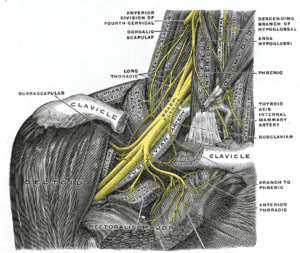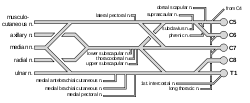Long thoracic nerve
The long thoracic nerve (external respiratory nerve of Bell; posterior thoracic nerve) supplies the serratus anterior muscle. This nerve characteristically arises from the anterior rami of three spinal nerve roots: the fifth, sixth, and seventh cervical nerves (C5-C7) although the root from C7 may be absent. The roots from C5 and C6 pierce through the scalenus medius, while the C7 root passes in front of the muscle.
| Long thoracic nerve | |
|---|---|
 Nerves of the left upper extremity. (Long thoracic labeled vertically at shoulder, to left of artery.) | |
 The right brachial plexus with its short branches, viewed from in front. (Long thoracic labeled at center, third from top.) | |
| Details | |
| From | brachial plexus (C5-C7) |
| Innervates | serratus anterior muscle |
| Identifiers | |
| Latin | nervus thoracicus longus |
| TA | A14.2.03.012 |
| FMA | 65275 |
| Anatomical terms of neuroanatomy | |
The nerve descends through the cervicoaxillary canal behind (posterior to) the brachial plexus and the axillary artery and vein, resting on the outer surface of the serratus anterior. It extends along the side of the thorax to the lower border of that muscle, supplying filaments to each of its digitations (finger-like projections).[1][2][3]
Damage
Due to its long, relatively superficial course, it is susceptible to injury either through direct trauma or stretch. Injury has been reported in almost all sports, typically occurring from a blow to the ribs underneath an outstretched arm. The long thoracic nerve can also be damaged during surgery for breast cancer, specifically radical mastectomies that involve removal of axillary lymph nodes.
Injuries to the nerve can result from carrying heavy bags over the shoulder for a prolonged time. There are also reports of isolated damage to this nerve as a variant of Parsonage Turner Syndrome, an autoimmune disease.
Symptoms are often minimal – if symptomatic, a posterior shoulder or scapular burning type of pain may be reported.
A lesion of the nerve paralyses the serratus anterior to produce winged scapula, which is most prominent when the arm is lifted forward or when the patient pushes the outstretched arm against a wall. However, even winging may not be evident until the trapezius stretches enough to reveal an injury several weeks later.
See also
- Backpack palsy
References
- Fischer, J. (2012). Anatomy of the Axilla. Fischer's Mastery of Surgery, 2 Volume Set. Retrieved September 20, 2015 from http://www.r2library.com/Resource/Title/1608317404/ch0046s1193
- Stedman's Medical Dictionary.
- Bertelli, Jayme Augusto (2005). "Long Thoracic Nerve: Anatomy and Functional Assessment". The Journal of Bone and Joint Surgery. American Volume. 87 (5): 993–8. doi:10.2106/JBJS.D.02383. ISSN 0021-9355. PMID 15866961.
Additional images
 The right brachial plexus (infraclavicular portion) in the axillary fossa; viewed from below and in front.
The right brachial plexus (infraclavicular portion) in the axillary fossa; viewed from below and in front. Brachial plexus
Brachial plexus Brachial plexus with courses of spinal nerves shown
Brachial plexus with courses of spinal nerves shown
External links
- Long_thoracic_nerve at the Duke University Health System's Orthopedics program
- synd/2384 at Who Named It?
- Anatomy figure: 05:03-07 at Human Anatomy Online, SUNY Downstate Medical Center - "The major subdivisions and terminal nerves of the brachial plexus."
- Long Thoracic Nerve - BlueLink Anatomy - University of Michigan Medical School